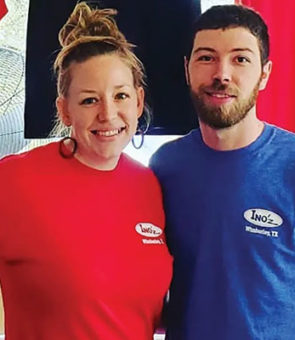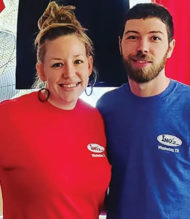Posted on December 5, 2022
Chill’s on the Creek is a family-friendly restaurant in Wimberley, Texas. They have amazing food combined with an amazing outdoor view. It’s the perfect place to chill with your friends and family. Chase and his wife worked for years in the restaurant industry until they were offered a chance of a lifetime – the opportunity to purchase the restaurant they both managed for years. They thought they knew exactly what they were getting into, but just a few months after they signed the papers, the world as we knew it came to a halt. Almost 3 years later and they have yet to see a consistent pattern of business but are still enjoying the ride. Join Steph Silver as she talks to Chase. Learn how he went from a managerial role and waiting tables to the owner of a restaurant. Find out how they survived and overcame the pandemic to make Chill’s a Wimberley staple.
—
Listen to the podcast here
Buying A Restaurant 2 Months Before Lockdown With Chase Philemon
Our guest is Chase Philemon, owner of Chill’s on the Creek, a family-friendly American restaurant with an outdoor patio and dog-friendly picnic tables. Thank you so much for joining us.
Thank you, Stephanie, for having me.
I am so excited to have you. There had been a lot of changes over there. We will talk about all that but first, tell me a little bit about yourself and how you came to this place of being the co-owner of Chill’s on the Creek.
It has been a long stretch. I’m from Beaumont, Texas, originally. I moved all around Southeast Texas growing up. I ended up going to Colorado and Durango for my senior year of high school, which is where my grandparents have barbecue restaurants up there. My first job ever was smoking barbecue. That ties into one of the things we started doing, which was smoking some stuff at the restaurant. I was up in Colorado for two and a half years doing that with the family business at Serious Texas Bar-B-Q up in Durango, and they have seven throughout Colorado.
Colorado needs some good barbecue.
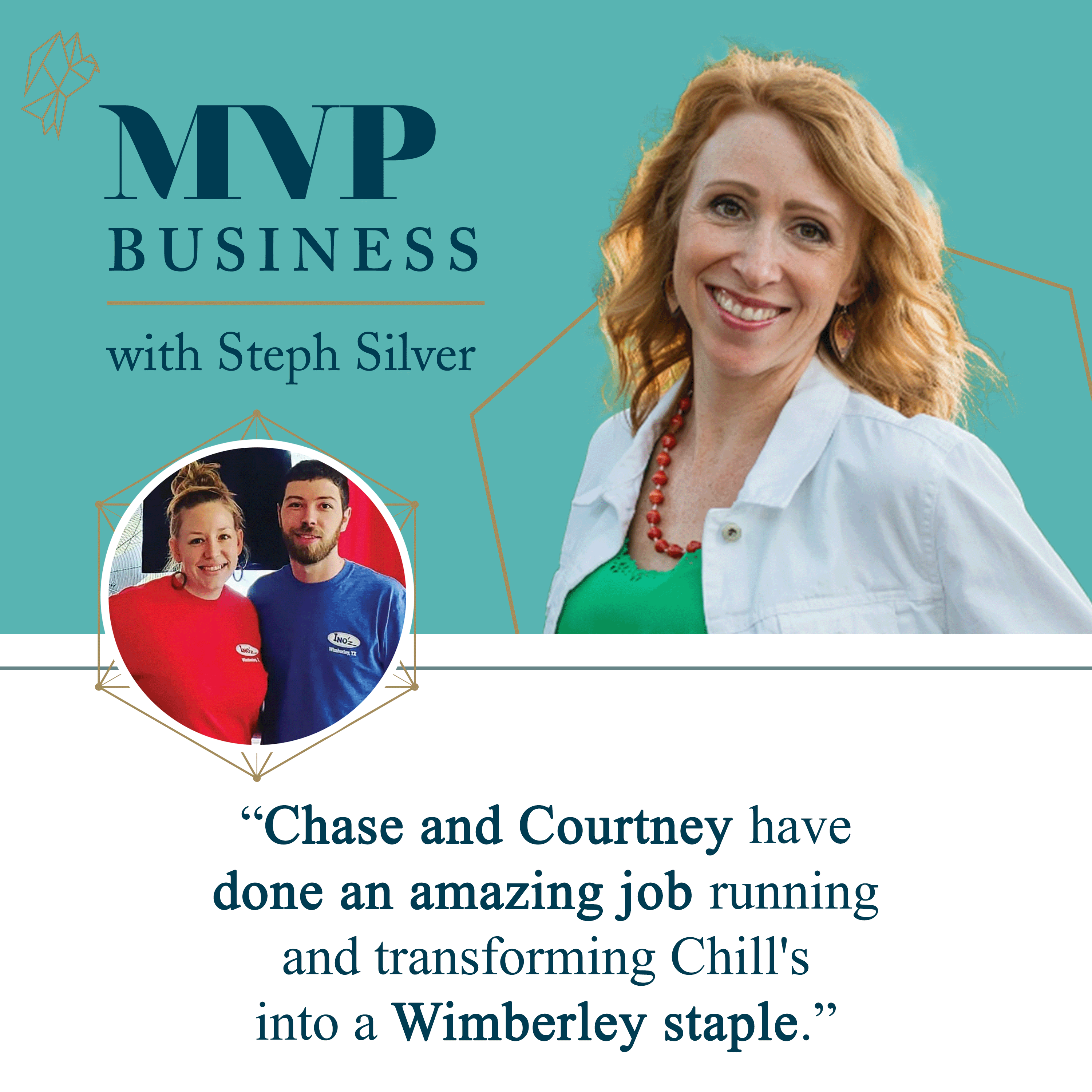
It is a good niche because there are a lot of Texas tourists up there. It is like dropping a Tex-Mex place up there. I think that would go crazy as well.
Chuy’s has a franchise up there now. My sister lives outside of Denver, and she was excited because there is not much. It is a bunch of green sauce.
I used to tell people down here when I got back that the salsa is cilantro based instead of tomato because it is whole leaves of it. I like cilantro, but not quite that much. Durango was a little valley town tourist based. It has grown more. When I drove in from San Marcos into Wimberley the first time, I was like, “This is the Durango of Texas.” It is the same. When I was driving into the valley and seeing it as it is, it reminded me a lot of that. That is one of the reasons I was like, “I want to be here.” From Durango, I was there for two and a half years, then moved back to Texas and started cooking in Southeast Texas a lot of catfish, shrimp, ribeye, and stuff there.
Wimberley is the Durango of Texas. Click To TweetI was down in the Galveston area for a bit, and I got moved out from Hurricane Ike. I evacuated to San Marcos. I went back down there, and my house was not livable. We floated around for a second, trying to find a spot because my friend’s car was messed up. I was helping him out. It was a hot little stretch, and I ended up in Friendswood for a little bit for no reason other than that is where I got.
My grandparents were living across the creek from Ino’z at the time, and my grandma had two heart attacks and a heart transplant. I was there to see her as well as my step-grandfather from Southeast Texas, who played music his entire life. The other reason I was there was to learn guitar for a bit. I was able to walk across the creek every day to wait tables at Ino’z. That is how I got into Wimberley. I had some other family right over behind St. Stephens. My aunt had triplets who were still going to school there. I have a lot of family in town. We are all from Southeast Texas, but there was a chunk in the Hill Country all of a sudden. I did that for a bit.
I met Courtney, my wife, at the restaurant. I trained her as a server. As I was going to ACC, she became my manager. She went and was doing part-time stuff as a vet tech. I was her general manager. January 2020 was a perfect time to purchase a business. We took over as owners. Three months into that, the pandemic hit. It was an interesting little stretch there.
You started off at Ino’z waiting tables and worked your way into management in and out based on what was happening in your life and going to school. Your wife Courtney did the same. How did it transpire? It is a lot of people’s dream to work their way up and go from waiting tables to owning their own restaurant. For most people, that’s a huge leap that never comes to fruition. How did that come to fruition for you and Courtney?
Tom Keyser, the previous owner, had been trying to do that repeatedly with some general managers, and it never worked out. He had offered it out to me. The restaurant industry was the only thing I had ever done. As I said before, in Durango, I was doing the barbecue stuff. I got back. I was cooking in Southeast Texas. I came over here waiting tables. It wasn’t something that I necessarily planned to continue doing for the rest of my life, but when that opportunity arose, I initially said no.
My uncle was going to do a barbecue, mirroring what my grandfather was doing in Colorado, but he was going to do it in the San Marcos area. I was considering that. Tom asked again and weighed the two options, and decided to go with taking over Ino’z. That was a conversation with Courtney as well, deciding which route to go.
Once we made that decision, it was more training as far as going from the managerial role and the GM role to what that means to own a business. It was a process to go from one to the other. It was slow-moving. We took our time with it. I had already been there doing accounting, I have a two-year degree in Association. I had already done a lot of accounting through that. I then started doing the actual books at the restaurant. I had a good grasp of what was going on behind the scenes with that. We took our time and slowly made that transition.

Buying A Restaurant: Going from a managerial role to owning a business is a huge leap. You really need to take your time with it and slowly transition in.
By the time we did fully do it in 2020, it felt like it wasn’t a change at all. Tom stepped away more and more as it got close to that time. We were running it all of 2019. 2020 was the time when everything was signed and official. We felt comfortable at that point moving in and going forward, not knowing that a pandemic was going to hit and they were going to say, “You can’t sell food at your restaurant.”
That’s great timing there. Before we get to that, going from working in the business, in general, the food and service business and being the general manager, how long were you working at Chill’s before you got offered this opportunity?
I’m going on fourteen years there, in general. I would say at least ten years as a server, bartender, manager, and all of those.
That’s a long time. You look young for your age. You have a lot of experience.
I don’t know about that.
You do have two small kids.
I do have plenty of gray hair. They are hiding under the hat. That is from the 40 children at the restaurant and the two at home.
You had quite a bit of time to learn the restaurant inside and out. You knew the kitchen and front of the house because you waited tables. You knew the books and got further into them. All of that was great training, but how does one go from manager to ownership? Was there a big buy-in? Was it a slow partnership agreement, if you don’t mind?
We became 10% owners in 2019. We bought the remaining 90% of the shares of the corporation officially in 2020. That was all that was. It was moving numbers around at that point. We were making payments as that. After 2020, we were making payments monthly towards the remaining 90%.
It makes the pandemic even more terrifying because you just took on this big loan, and now nobody can step foot in your restaurant.
The worst word in the restaurant industry is uncertainty, and that was a lot of uncertainty. Nobody knew what was going on anywhere, for that matter, but definitely in a restaurant. We have no idea what is going to happen. We are technically essential so you can continue. You can’t sell food in the restaurant, but you can do to-go, delivery, curbside, and things like that. We moved to that as we had to. At some point, they allowed dine-in again but restricted the spacing.
The worst word in the restaurant industry is uncertainty. Click To TweetWe had the plan to put the stuff down at the creekside of the lawn area that we have long term. The pandemic expedited that process. It allowed us to space everything out and get closer to the capacity that we normally would have had. There were some good things that came out of the pandemic because that led us to do that a lot quicker than we were going to. It is a cool spot now. Because of that, we have been able to fine-tune it as we have gone much sooner than we would have done otherwise.
For those who aren’t from Wimberley, there is a wonderful space in front of Cypress Creek. Your restaurant is on Cypress Creek, but it is up a hill, and it is not super close to the creek. There is this huge space that looks like a public area, and some of it is a public area, but a big portion of it is your lawn.
From our staircase up at the square entrance, all the way down to the creek is our property. We have some seating down there now with picnic tables and umbrellas. Some of those light up at night, so you can see a little better. We have done things and stuff to make it a little more appealing to the public. We then started adding some games down there for the kids like a giant Connect 4, cornhole, and things like that. While you are waiting at a table or hanging out eating before the food gets there, you can do those things to keep your time.

Buying A Restaurant: Chill’s on the Creek added some games like Cornhole and Connect 4 to their restaurant. So when you’re waiting at your table, you can just do those things to keep your time occupied.
I was happy to see those tables stay after the pandemic because I thought that they would be a temporary addition. I’m an outdoor person. I always prefer outdoor seating, even when it is 115 degrees.
I wish we are like you because most of our seating is outside, but in the creekside seating down there, there are eight tables there, and there is a good chunk on our patio. We have twenty tables inside in total, and some of those are small. Most of our seating is that outdoor space between the two patios and the creekside. Anytime we go there with our kids, we sit down there so that they can run around and play some of those games we have now. It is where I want to be with children.
Let’s back up a little bit. When the pandemic hit, and you walked through the whole process, how did you and your wife emotionally handle that big change of the first shutdown, and you had to pivot completely and create a new form of to-go? Did you deliver?
It was just months when we took over this business. We are going to make it work, whatever we have to do. We started doing to-go. They allowed the to-go alcohol, which was cool, and curbside delivery. We did all of those things. Initially, we hovered around 40 employees with host, busters, kitchen, and front of the house staff. Whenever that happened, we went from that 40 mark down to about 5 because we couldn’t do anything else. That was not something we wanted to do. We kept our management team, front and back of the house, and the guys in the kitchen who were cooking. There were 3 or 4 of us in the front figuring out the rest of it.
We forwarded calls from our office phone to the downstairs second phone so we could get more phone calls in and figure out a process. We used the bar top as the bagging area and marked the things so we knew where they went and the right people got them. A delivery range that we never stuck to was like, “If you want it, we’ll figure out the process of this, how this is going to be packed in a car where it is not going to spill everywhere, and get it there in a timely manner and figure it out.” None of us had ever been in the place with delivery. It was interesting. Weirdly, it was a fun time. It was almost people who knew each other well and were able to work well together. It was the most efficient has ever been because there were only a small amount of people doing it. You don’t have to monitor, no reprimanding or anything like that.
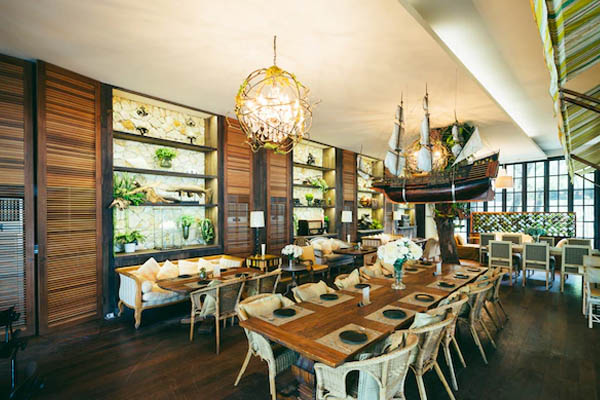
Buying A Restaurant: Owning a restaurant during the pandemic was a weirdly fun time. It was only a small crew so everyone knew each other and was able to work with each other really well.
It was all the key staff. They were dedicated, and everybody who was working was happy to be working at that point. What did you learn the most? What was your biggest lesson from that time period do you think?
I don’t know. It was such an odd time. It is possible to persevere and continue with the business. Once the PPP loans and stuff were handed out, that is when we were able to bring the staff back.
How long did that take?
As soon as I started hearing about anything where we could get assistance to get the staff back, and that was the PPP specifically, I had everything filled out and ready to be filed as soon as it was allowed. I was already talking to the people in Arizona. Shelly Hicks, over there, was helping me a lot. We had it ready to be sent the moment it was able to. That made it to where we got it quickly. I don’t know the timeframe of all that. It was such a cluster.
Those last two years have been like a blur.
There’s no normalcy whatsoever. We got that quickly though. I don’t remember exactly how quickly, but as soon as we knew we were getting it and we had a date that we should expect it, I started contacting the rest of the staff and asking, “Who wants to come back? This is what we are going to be doing. We are still doing the delivery.” Once we got the feedback in and everybody who wanted to come back did, we integrated them into the system we were doing, and also started renovating the restaurant.
You started renovating the restaurant when you had a little bit more staff on hand, but the restaurant wasn’t full.
Before they all came back, we were still allowing people to walk in and get the to-go food. We shut that down once the staff came back. We just did curbside and delivery for that stretch so we could renovate and paint and do whatever else we needed to do in certain areas. At times, I staggered through the restaurant. We repainted the whole interior, pressure-washed the patio, and did all the little stuff we could do. We got a new paint job inside, but it was not professionally done. Everybody was getting paid close to what they would have been getting had we been open normally. The goal was to get them to where they could support themselves again.
What a great lesson there to see that as an opportunity and to know that even though things were still uncertain, you had the PPP loan, but we still didn’t know when things were going to get back to any sense of normalcy. Thanks and congrats to you for reinvesting in your team and for seeing the opportunity to invest in the business, and get it up to where you have the confidence to say, “Someday, we will have people in here again.”
The uncertainty was a big one. It was not knowing what was going to go on. The main thing that we enjoy about being owners is that we can’t employ a chunk of the community. We got guys in the kitchen who’ve been there for ten-plus years. We have a solid core foundation, but the restaurant industry has a lot of turnovers. There are a lot of high school kids that do the hosting or busing and stuff like that. The main thing that we are able to do is to provide jobs and income. That is the main thing we are able to do, and we want to continue to do.
We talked about the seating down on the lawn. I was a server for many years, as were my mother and my sister. The first thing I thought of when I saw that seating down there was, “I wonder how difficult it is for a server to keep up with this section or a set of servers.” Has that been a challenge or has it worked out?
Initially, it was. That was for many reasons. The main one was that we were still on handwritten tickets. That meant that they had to take an order down there, walk all the way back up, and deliver that handwritten ticket to the bartender for drinks and to the kitchen in a little tray that they would hang on the line for the food. It was horribly inefficient when we were doing that. As we got a POS system and all the handhelds everywhere, we are running around. We have a couple of those now, and those are specifically for the lawn servers so that they can be down there and send the orders before they even leave the table. That’s helped a lot.
The part that is still difficult at times is because those tables down there are a little larger than the rest of ours, that is where a lot of the larger parties sit. You are talking about not only is it the farthest point from the food and the drinks you can get. It is down a staircase, and it is the biggest party possible. That is the one thing where we have to work as a team.
If they have a party of twelve down there and there is food in the window, we then all have to help run that. There are days when a person is down there for a shift and the next time they are up at the top doing the patio and indoor seating, but they know that they are going to be in that situation at some point. Everybody is good about helping each other.
You made a lot of changes aesthetically and added more seating which is a greater opportunity for income. Were there any other changes that you made, you added the POS operationally or from a hiring and management standpoint that helped you be more efficient or profitable?
The biggest one is probably the management. For a long time, when I was a manager at Ino’z, you had made most of your money waiting tables. You were a serving manager. You had a full section of tables while you also managed the entire restaurant. You were there with a party of six trying to get a drink order, and you have a server walking up telling you that they have a complaint that you needed to address, and everything else that would go along with that. That was not efficient either.
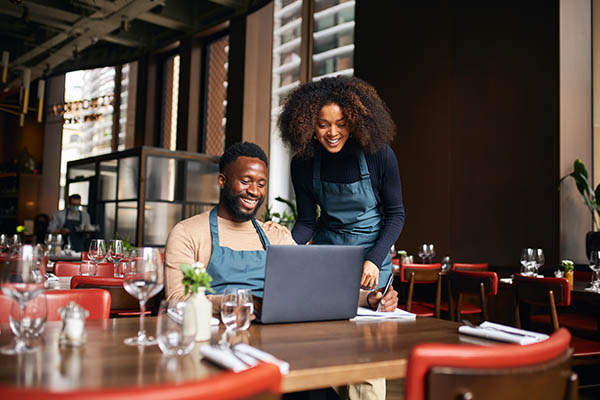
Buying A Restaurant: In some restaurants, managers made most of their money waiting tables while also managing the entire restaurant. Managers just need to focus on managing the restaurant.
We moved them to a salary-based system, and they don’t have a section. They are waiting on just managing the restaurant. That was probably the biggest one because that made it incredibly more efficient. They are able to monitor what is going on the whole time, be in contact with the servers in the front and the kitchen in the back, and figure out what we need to do.
The other one was probably putting a host in. Before, it was always open seating. I don’t even know how to go into hell. The combination of the two is crazy and how much it has changed it. I was a managing server with no busers, no host, and no way to control anything that was happening. You would have an entire section that was dirty, and there are guests that have walked down waiting for those tables, but they have to go and jump onto them before anyone else does because there is nobody to tell them who can go where.
That alone was crazy because you are busing tables around them because you don’t have busers. It was you and the other servers doing that. They would sit down. Because you couldn’t pace out anything for the kitchen, they would get to a point where they couldn’t take any more orders. They would get stacks of paper in their bucket and they would get to a point where they just shut the kitchen down.
We would walk up to that table who had waited 45 minutes or so for a table, finally hawked one and sat down. I then walk over as a server and manager. I told them that they couldn’t order any food. They were so pleased all the time. That was rough. No one does that. They didn’t know what was going on. You are trying to explain, “We don’t have the kitchen to back up.” They were like, “How long is that going to be?” I’m like, “45 minutes to an hour. I can’t even take your food order at all,” because if I do and everyone else does that, as soon as we open the kitchen back up, it happens again. It was chaos. The combination of being a manager and the hostess being able to control the flow of the restaurant has been amazing.
I want to pause right there and say for anyone who hasn’t worked in service, and they see that they walk into a restaurant, there are empty tables and they say, “Why can’t we sit there? There are empty tables,” especially since COVID and all the stuff changes, there are reasons, people.
There are lots of reasons. For example, we were short of one server. One was sick and stayed home. We didn’t have anybody else to replace him. We ran the whole day with one less server. At times, you are doing it for the servers, and at times, you are doing it for the kitchen. No one would have ever designed a restaurant like Chill’s on the Creek, in my opinion. The entry points are hidden and weird. Not only that, there are three of them. You know where you are coming from. If you come up from the Creekside area, there is the staircase up and the ramp adjacent to that goes to the sidewalk. There is also the staircase from the top.
At any point, people can walk in from any of those points. At one point, when we first started with the host, we had a host on the ramp and on the staircase at the gate to where we could catch anybody, but we ended up having the person at the ramp sitting there 90% of the time. We stopped doing that and had a sign that said, “See host.” No one would design three entrances in the first place.
You want one entry point where they can go in and talk to the host, and then everything follows from there. Most places would hide all the empty tables you were talking about. You wouldn’t have them visible to every single person that walks as much as you possibly could, at least. In our situation, they talk to the hosts. We are on a 30-minute wait. You can go down to the bar and get a drink. We are telling them to walk past all those empty tables at this point and walk right past them, go to the bar, or there could be more empty tables.
On top of that, the entry point situation is bad enough, but then our kitchen is at the farthest point of the restaurant. Normally, you would want that looped in the middle there where we can all make a rotation, and the bar is not much farther than that. Everything we are serving as far as it can be from the guests that are getting it, and we have people running in all these entry points. I never would design a restaurant like that but having it, it is already that way. We took it over as such and we knew what we were getting into.
We have tried to make this system as efficient as we can with what it is. We have a wait-list thing where we can text you whenever the table is already. If you want to shop around, you can do that. If you want to hang out in the creekside area with some drinks, you can do that. As soon as we text you, we can get you to the table.
We started doing something we call cocktail service, where if it is a fifteen-minute wait, we can go and put them at the table where they are going to be. They can get drinks in some cases, appetizers. As soon as we are ready to take their full order, we do that. They are in line quicker that way than wandering the square and us waiting for them to respond or come back after we text them. It is still a work in progress as far as efficiency is concerned and trying to make it work as well as I would like it to. It has gone leaps and bounds from where it was.
You have made changes to the technology to a little bit of flow management. You have also made quite a few changes to the menu. Talk to us a little bit about how that menu has changed and what you have in store.
It goes back to where I’m from and where I moved around. I’m from Beaumont originally, which is right on the border of Louisiana. There is a lot of Cajun influence down there. I always say the one good thing about Beaumont is there is good food. There is not much other than that. I’m sorry, everybody from Beaumont, but I don’t go back down there for much more than that. My family is still there. My uncle has Boomtown BBQ over there. It is a tiny Houston. Houston has good food. There are a lot of different types, and that is what Beaumont is. There is more of an occasion influence in Beaumont than Houston at times.
The best thing about Beaumont, Texas is the good food. Click To TweetOur boudin balls are probably the most popular appetizer at this point that we sell. We get the boudin from Beaumont. It is DJ’s Boudain from down there. That is what I grew up with. When I found out I could get it up here as easily as I could, I was like, “That is happening.” We take that boudin. For people who don’t know what boudin is, it is a rice mixture with pork and Cajun seasoning. It is encased like a sausage. We take that out of the casing and ball it, bread it, fry it, and serve it with queso.
The reason we serve it with queso is where I’m from, they would take a whole link of it and ball it into one huge boudin ball, and in the middle of it, they put cooled queso. Whenever they fry it, it turns into oozing queso out of the middle. That is the first way to eat it. We didn’t want to do that at the restaurant. We served five small ones with queso to dip it in.
That is where the Cajun influence came from. We make our own gumbo in-house. It is called Pop’s Gumbo on the menu, which is that step-grandpa I talked about that I came to live with who taught me Beatles music and the guitar. That was his version of it. Everybody everywhere has their own version of gumbo, and everyone likes to let me know that at the restaurant. There are some people who this is the only way they do it in Louisiana, but some will make their roof so thick that you stick a spoon in it, and it doesn’t move. That is not how I want it.
There are some who do it, but that is not where ours is at. Ours is a little soupier. It uses a dark roux. It doesn’t have a Louisiana kick to it either because I want children to be able to eat it if they want. It is served over white rice like our chili is because that is how chili is in Southeast Texas. In Southeast Texas, if you eat something, you put white rice under it. That is not everything, but it is a lot of things. There are a lot of people that come in and see that, and immediately know that I’m from Southeast Texas. It might be called Golden Triangle Chili now on the menu. I think we switched that. Golden Triangle is three towns down in Southeast Texas that make a triangle on the map.
There are a few things that I brought from the Southeast Texas region, Beaumont specifically. Once I moved to Colorado and started doing the barbecue, I was doing a lot of smoked meats. We were doing a lot of turkeys, pulled pork, brisket, sausage, and ribs up there. When I got back down to the Galveston area after Colorado, I was cooking a lot of shrimp, catfish and ribeyes.
The menu we have now at Chill’s on the Creek is a culmination of all those things. The smoked turkey club, specifically, is probably the most popular sandwich we have on the menu. A lot of people think of turkey, and they think of their uncle’s holiday turkey that they have made, which they don’t necessarily know how to cook. It is dry and not the most edible thing in the world. That is not what ours is. It is moist and doesn’t have a whole lot of seasoning to it. We put seasonings on it, but we don’t go over the top with a lot of the things we do. We let them be and do their own thing. That is why I feel like it is good.
A lot of people think of Turkey as their uncle's holiday Turkey which is dry and not edible. Chill's on the Creek's turkey is not that. Click To TweetThe barbecue, specifically the turkey, has taken off. I started doing that as a little thing for some of the family holidays and Ino’z Christmas parties. Everybody was like, “You need to do this at the restaurant.” We started as a special way back and slowly migrated it into the menu. The other thing the barbecue does is it helps the kitchen because the pulled pork and the brisket are cooked overnight, and the turkey is cooked in the morning. It is all done by the time it is ready to be served. We slice it, and that helps them. When they get a full order of all barbecue, it is going to come out a lot quicker than if we have to cook everything to order, which we do with everything else.
That’s a tip, everybody, if you want a quick meal at Chill’s.
All of you need to order it because if one of you decides that they want a well-done rib eye, you have to wait for that well-done rib eye. The barbecue has been fun, and it got a lot of things that helped us, but it was also good. That seafood I was talking about before, the fried shrimp is one of the newer things once we switched the name that we added on there that we didn’t have before at all. It is good too. I eat the shrimp po’boy more often than I probably should. At this point, I needed that.
The cheesesteak tacos have been up. We had a cheesesteak forever. Whenever we change the name, Dylan Lambert is my kitchen manager, and Will Cameron is my other kitchen manager. We all like to cook and eat. We like to mess with things. If it is better, we are probably going to move to it even if it has been the way it was for ten years. If it is that much better, we will.
There is a balance there between giving people what they have enjoyed for as long as they have and making something better. For the cheesesteaks specifically, we already hand-cut all of our ribeyes in-house. We already have the logs of ribeyes. We take that ribeye and slice it through a meat slicer, and we shave it. It is shaved ribeye on the cheesesteak with our queso, bell peppers, onions and mushrooms. The cheesesteak sandwich is good. The tacos are good too. Between that and the shrimp po’boy, I’m going to have to try to eat something else. I go on these little tiers where that hit specific things. That is where I’m at. I need to move to something else.
Did you cook much before you started working in your grandfather’s barbecue shop?
I did, but it was probably more baking. I have been making chocolate chip cookies from scratch since I was thirteen, also pancakes and breakfast stuff like that. I did more of that than the rest. I cooked but I didn’t go crazy with it. I learned more because I had to. I was living on my own at about fifteen. I was cooking for myself. It helped my cooking knowledge because it was a necessity at that point, but the cookies, though.
Do you serve those at the restaurant?
We do. That was new as well. They were freshly baked when you ordered them. They do take about ten minutes. It helps if we know that a little ahead of time but if not, you can chill and wait. I have been making them since I was about thirteen. I have tweaked that recipe up to a point where we put them on the menu. They were at the point where I was like, “I’m probably not going to mess with this anymore.”
You step away for a minute to go eat a taco.
Those are fun because I have been wanting to do that for a long time. Doing that in a restaurant is interesting because there are many things that go into play, turnover, and things like that. Doing something where you are baking it to order and extending the stay of that if you don’t know ahead of time or if somebody doesn’t realize initially that it takes ten minutes to bake something, they could get upset about that. It has worked out well. We sell more of those. We also have Texas Pie from Kyle that gives us some pie. Between the two, neck and neck, cookies have been jumping a little bit. I don’t know if it is the holidays or what, but we have been selling more of those. I’m proud of the cookies because that has been a lifelong endeavor at this.
It’s fun to have that on the menu. I have a sister-in-law who has been making sourdough since college. Her best friend owns a restaurant. She is trying to get Julie’s sweet sourdough on her menu. That is exciting. I love that when you bring those personal things into your business. You mentioned turnover. That is always a big endeavor and challenge in the service industry. Is there anything different that you have done with your hiring process? Do you do anything to keep your team members? You have a lot of people that have been there for what seems like a lifetime in the restaurant industry, but then you have all this new blood coming in. Is there anything you have done differently there?
Not since I have been the general manager or owner. We are a little family. That is how we all feel about it. I have known Will and Dylan since I have been there. I was hanging out with them whenever they were cooks in the kitchen, and I was a server. They knew my wife in high school. That is the common core guys. We got some others like Marcos in the front who has been there for five years. He was at Texas State for a bit. Drew has been a server for a long time, and he has been going on for seven years.
We know each other well. We had fun with each other, and we got to make it a chill environment for the rest of the staff. It is tough to do at times because there is a lot of stress that goes into not just managing and owning a restaurant but serving tables or cooking in a restaurant. Part of it is whether it is Will and Dylan in the kitchen, Courtney and myself, Marco or any of the management, we have done everything. We know what it’s like to wait tables and get stressed. We know how to cook in line and get stressed out or have too much put on us.
We have manager meetings where we all sit down and voice our concerns and what we think could improve, or how to attack things as a group. We are trying to make it an environment where people want to be there and want to be there for longer than they may think. They want to be there. We know that you are going to have a turnover.
Seventy percent of our staff is from coming from San Marcos. We have a chunk more in the kitchen that are living in Wimberley. We have a few servers, but a lot of those are Texas State students that are going to be here for stretches. They are going to have a dorm to stay in for a stretch. They are gone for two and a half weeks, and they come back in again. They then were like, “I graduated. I’m gone.” We’re keeping it where we have people who know what they are doing and others who can train the new ones coming. The constant ebb and flow of it is tricky, but the environment that we are creating is the best thing that we can do to keep the staff and keep them happy.
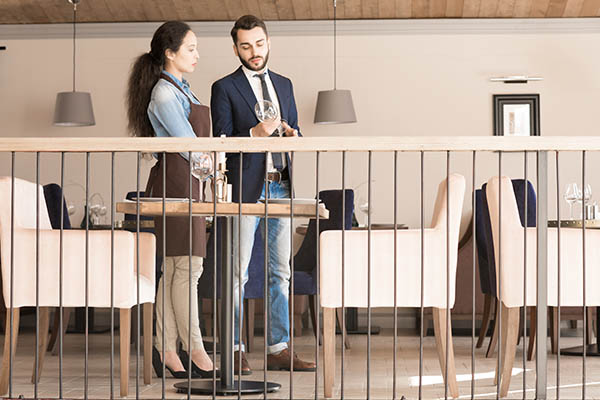
Buying A Restaurant: Have people on your staff that know what they’re doing and can teach the new people coming in. It’s a constant ebb and flow. You just have to create a good environment to keep the staff.
Now that you have gone through being an employee at this restaurant, the transition of ownership, going through some tough times, and now it seems like we’re in a semblance of normalcy, is there anything that you would go back and do differently?
We wouldn’t be where we are right now if we had done anything else previously. You don’t know what any small change would have led to. I’m sure there is something we could have done better. I’m not saying that, but I like where we are right now. I like the plan moving forward. I don’t think there is much I would have gone back and done differently.
You and your wife own the restaurant together. You have two small children. How in the world do you balance those things?
We had Hill, who was the restaurant baby. We were still in full-swing management at that point. She was managing. I was managing alongside her. One of us would have a morning shift. The other one would have a night shift. We would bring him up for shift change. The entire staff knew Hill. He knew all of them and he was happy. He was running around and excited to get that public interaction. We did that for a bit.
Cora, we called her the COVID baby because she did not get any of that. She is a little more reserved because of that. Once we had the two for a minute, we were continuing to both manage and be up there. I might have 2 or 3 shifts a week. She might have the other 2 or 3, and we had other managers picking up the rest of those shifts out the week. We would balance it like that. One of us was home, and one of us was at the restaurant. We would get a babysitter when we had to stretch.
The pandemic part was odd because they weren’t able to come up at all. We had a lot more babysitting going on then. It was tough because we didn’t get our schedule any different from the rest of the staff. It is a weekly schedule coming out. We would figure out, “We are working these days. You are working on those. When do we need a babysitter? Is a babysitter available?” We roll through that every week. It got to a point where we were like, “This isn’t the best route anymore.” She is staying at home more and I’m at the restaurant with all the shifts that we jointly had.
She still comes up and does things with the staff and does certain aspects of what we were doing before, but she is not on shifts anymore and not doing the accounting that I was training her on and stuff like that. It has been a lot easier on the scheduling aspect of things. She is there and if she needs to get a babysitter for whatever it might be, she knows that because she doesn’t have to figure out when she is working at the restaurant first. That transition has been nice, but it is still pretty new. We are still figuring it out a little bit. As far as having to plan everything out, so far, it has been amazing.
That will probably shift again when both are in school. You will have the same problem with spring break, Christmas break, and summer break.
They are both at Blue Hole Elementary right now at pre-K3 and kindergarten. This has been the first little stretch where they have both been in school. That has been different. We had Thanksgiving break and getting used to that all of a sudden, and here is a week where they are all home, and my sister came down from Houston with her two children. It was a lot of children. We are used to that because we had some other friends with kids in the same age group. We had at least eight children running through the house, and 6 to 8 adults hanging out. Chaos is where we are.
You run a restaurant. You are in the middle of chaos all the time.
That is one of the new shirts that we are coming out with, “At Chill’s, it is only chaos.”
What advice would you have for anyone out there who is questioning whether or not they should take that leap into a new venture or something that they are passionate about?
Know what's going on before you jump into it. Knowledge is key. Click To TweetIt is tough for me to throw that out because I have been in this industry for so long. I knew what I was getting into, and no one expected a pandemic to hit like that. I’m a big researcher. If I’m going to go do something new, I’m going to know as much as I can about what is going on before I get into it. Knowledge is key before you jump in.
Also, being willing to put up with a little bit of chaos in the middle. You never know what you don’t know until you get into it. Thank you so much for sharing your time and your story with us, and sharing your business and your family with the community. It is an honor to know you. Thank you, everyone. If you like it, tell your friends and follow us on Instagram or LinkedIn. The mission of MVP Business is to dig deep into the lives of true leaders so that others can follow, knowing that the path isn’t always easy, but the journey is worth it. Enjoy the day and live with passion.
Important Links
- Chill’s on the Creek
- Serious Texas Bar-B-Q
- Chuy’s
- Instagram – MVP Business Podcast
- LinkedIn – MVP Business Podcast

